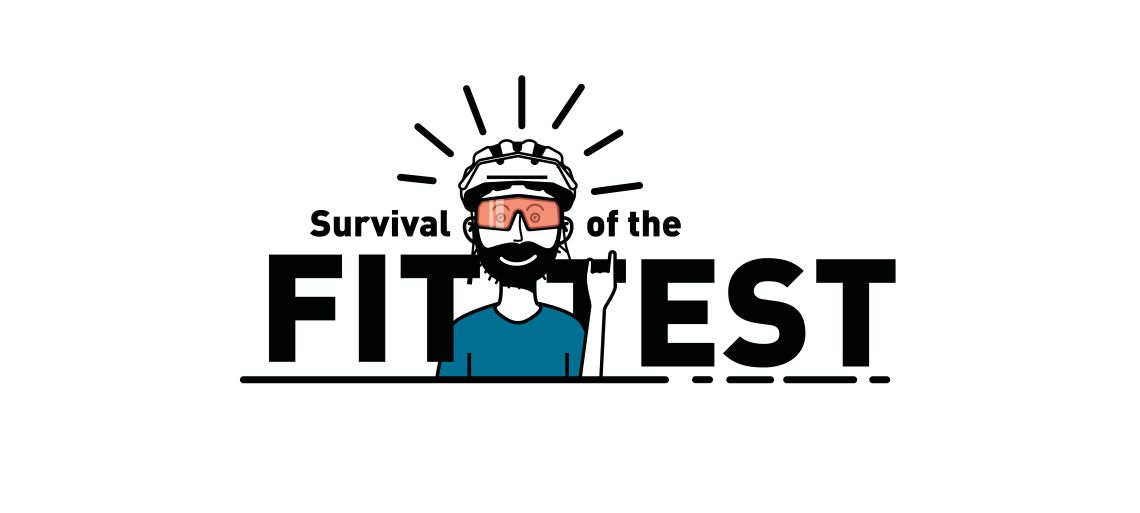Survival of the fittest – Here’s how to get pumped for your greatest season ever
Ah, bliss. Springtime. Time to get back on the bike and shed your waterproofs, but now there’s something else holding you back like quicksand on the climb… could it be – no, surely not… fitness? Ouch! While the biggest part of our sport is embracing gravity, it still pays to have the legs and lungs for the uphills as well as the general body strength to cope with the physical demands of riding. Could more fitness mean more fun on the bike?

The summer riding season is almost upon us, so you must be feeling pumped. Whether you want to build into race shape or are content simply shredding and having fun, knowing you’ve consolidated a foundation of fitness over the winter is a reassuring thought at this time of year. According to statistics, 90% of us start the season without sufficient fitness. This makes us wonder whether it truly matters if all you plan on doing from April to October is getting sendy with your mates, digging some new lines and riding them over and over again? The thing is, to make sure us riders can tackle the biggest climbs and handle the biggest hucks, we don’t just have to build trails, we have to sculpt our bodies too.
With winter’s dark, cold and short days, it’s all too easy to enter snooze-mode, but before you know it you’re about to drop into your first trail of spring without an ounce of fitness in your legs or lungs.
Don’t worry, we’re not advocating a strict 10-week, 20-second abs or crush-your-core training routine. Nor are we suggesting that you should start counting calories. You’ve still got muscle memory, so it’s just a case of reactivating that buried fitness and getting it ready for the trail parties. Even as the rowdiest rider on the trails, mountain biking puts us in a pretty fixed position for hours, which can result in imbalances and over-dominant muscle groups. Don’t believe us? Here are just a few reasons why it is wise to bring your body outside of its usual range of MTB motion and introduce some cross-training.
- Reduced risk of injury when crashing as stronger muscles make your body stronger and help prevent joint-related injuries
- Less armpump
- More concentration on the descents = better and faster lines because there’s more oxygen going to your brain
- More fitness = more laps
- Easier to drop your mates*
*if you really want to be a twat
The good news is that it’s never too late to get started on your #trailbod2022.

So, what’s the best sort of cross-training?
Here’s the thing: there’s no one-stop-shop when it comes to training. It’s all very individual and depends on a multitude of things: what gets you excited, your budget, what fits into your lifestyle, how the extra sport can fit in between work and life. As a general rule, the best training is whatever training you actually do – ideally with some sort of regularity. It can be tempting to scroll Instagram and copy the reps or weights that pro riders are lifting, but we advise against that. Just like those getting into martial arts for the first time probably shouldn’t go straight to YouTube with the aim of splitting a brick straightaway. In the following sections, we outline the available options and how best to get the #gainz.

Home Gym – a private gym with opening hours to suit you
If you don’t have a gym around the corner with 24/7 opening hours, permanently spick-and-span equipment, and no waiting time for the bench press, what’s the next best thing? Easy. Set up your own private gym in a spare room, your shed, or the cellar. Depending on the available space, your motivation and how much cash you’re willing to throw down, you’ll be covered for most exercises with barbells, dumbbells, weights, a rack and a bench. Using various weights, you can train power, plus strength and coordination while developing quads like Dangerholm, if that’s your goal. #neverskiplegday
For those with less luxury of space or who just prefer a more natural bodyweight training, the TRX is a great invention. Relying on straps that you mount onto door frames, hooks in your ceiling or even trees in your garden, you can give your core, back and shoulders a serious workout as you leverage your body weight to keep balance and hold the tension in the straps. After a few sessions of this, you’ll notice how you’re able to sustain your position and keep the bike upright next time you’re about to go over the bars. If you’re into gym classes, the TRX also comes with a monthly subscription service with livestreamed workouts.
Is this for me? Home gyms are ideal for self-motivated types with limited free time and a fair bit of prior knowledge about training.

CrossFit – where you’re held accountable by cheering peers
If group workouts are your thing, then we’d be surprised if you haven’t yet tried CrossFit. It’s a craze that has swept the fitness world in recent years, not just with classes, but also dedicated CrossFit gyms, championships, and much more. For MTBers, it provides a full body workout featuring cardio, strength and mobility, all linked with high-octane interval work. While it doesn’t specifically feature bikes, the lactate caused by burpees and the rowing machine is very similar to a high-speed sprint – being able to recover sufficiently and repeat the effort at the same intensity is definitely a bonus on the trails. CrossFit usually takes place in big groups, which provides added motivation, with similar cheer vibes when you set a new personal best that you’d get after pulling off a great jump. Of course, surrounded by fellow CrossFitters, you’re held accountable to see the session right through to the bitter end and boss the whole workout in the same way you’ll own the next long climb.
Is this for me? If group training sessions are your thing and you get bored easily by repetitive workouts, then CrossFit is worth checking out.
Note: It’s important to pick your gym carefully with Crossfit and make sure there’s an experienced coach.

Road riding – ready for the lycra?
Skinny tyres are traditionally ridiculed by mountain bikers, but considering how much we’ve got in common, it seems a little harsh. Road or trail, you’re in the saddle, enjoying the fresh air, and able to join in group rides. One benefit in winter is the absence of mud – although we can report grim conditions even on the roads depending on where you live, such as salt from gritting and/or the risk of black ice . Starting to road ride comes with a few requirements, though, including good roads, motivation and justifying the purchase of another bike. If you’re used to slow-rolling and chunky MTB tyres, road riding will make you feel like you’ve just gorged on Mario Kart mushrooms. Speaking of speed, the more you road ride, the more you’ll shift the dial on your subjective perception of speed, meaning that after nudging 90 km/h down a mountain pass, your next trail downhill will feel pedestrian speed. Another benefit to road riding will be its effect on your fitness: low-to-mid intensity group rides in winter might feel like a drag, but there’s truth in the saying ‘winter miles, summer smiles.’ All those hours spent turning the pedals will translate into endurance for long days on the trails. Sure, you may have some narrow-minded MTB buddies who take the piss out of you for the skin-tight garb, but once they realise that they’re being left in your dust, any scorn will rapidly dissipate.
Is this for me? Road riding doesn’t have to be all about power metres and peak performances. As we’ve proved through our sister mag GRAN FONDO, you can ride skinny tyres and drop bars however the hell you like. So, for those of you who aren’t put off by its uptight image and simply want a fix of fresh air and freedom, this is a good way to mix it up and boost your yearly distance total.

Indoor riding – like road riding minus the weather conditions
Indoor training on your own bike or a stationary spinning or watt bike can be a great way to get time in the saddle without having to worry about daylight, the weather., or wringing mud out of your kit (just copious amounts of sweat). While it sounds like hard work (and it is), there are now so many different ways to spice up the suffering. Zwift is one option – it’s a monthly subscription service that you can use on your phone, tablet or computer. At its most basic, all you need is a speed sensor on a simple home trainer, but you can also ramp up the technology with power metres and the like. We’ve compiled a detailed guide on how to mountain bike on Zwift, which you can check out here. In one of its fictional worlds, you can join social rides or races, so you’ll never have to ride alone if you don’t want to. Any rides you do on here can be automatically saved onto your Strava too. Zwift is based on gamification, turning your workout into more of a video game to keep you interested.
If Zwift sounds too gimmicky and you prefer hardcore spin class vibes, then Peloton could be the choice. Alongside a monthly subscription, the actual Peloton bike will set you back a big chunk of change and then some, but you get access to a huge library of live or on-demand workouts, as well pilates, strength sessions and boxing. You’re unlikely to get bored as you can take your pick from one of the many coaches to keep things feeling fresh.
Is this for me? If you want fitness gains without any of the stress of dressing for the weather or charging up your bike lights, indoor training definitely has its advantages (just don’t get too bogged down in the numbers).

Yoga – adding mobility and balance to your life
Hands up who else doesn’t stretch as much as we should? It’s always easier to sit on the sofa than do some stretches, even though we know how beneficial they are for our bodies. Fortunately, yoga is more than just basic stretching and nowhere near as boring as some people think. By following a series of movements and zooming in on our breathing, it helps to calm your nervous system and bring about a sense of physical and psychological balance. If we’re only ever sat on a seat at work or leaning forward on our saddle, our bodies get stuck in position, which is where yoga steps in to take us outside our usual range of motion. There’s a whole range of different styles, but we particularly like Ashtanga which is more dynamic than other forms. All it takes is a yoga mat, but what you get out of it is so much more: better mobility and better control over your body, which both result in an improved riding position through better weight distribution and an improved ability to deal with unexpected, tricky scenarios by being able to compensate using your weight more carefully.
Yoga also does its bit for mental strength, teaching you how to concentrate on being in the now and bring out the most from each session. Then there’s balance and strength – especially in your core and lower back. You’ve got to remember that yoga is a marathon and not a sprint: even just one hour per week can produce results over the long-term. There’s a ton of videos on Youtube, which could be a good starting place but given some of the positions and the importance of getting them right, you’re better to pick a local teacher with a style that suits you. No one is going to laugh at your downward dog or stiff hamstrings. Even though we compared yoga to a marathon, it’s definitely not competitive, so just have a go. As it has so many different approaches, you can use it to bring balance to your life or as a strength session. In any case, you’ll get more attuned to how your body moves – or rather, how you control the movements – and it’ll provide you with a nice break from everyday life.
Is this for me? If you have time to go about it slowly and think carefully about the movements, then yes. And for the rest of you that claim to not have time, make time.

Breathing – improved recovery and concentration through breathwork
In the words of Wim Hof, the Iceman: ‘You are stronger than you think you are.’ The Dutchman, who is known for crazy feats of controlling his breathing under the ice, says that it all comes down to the breathing technique. Interesting. As a training method for mountain bikers, it’s light on equipment and time – you don’t need anything at all, and it only takes a few minutes – and can have a great influence on your riding. When we get stressed, our breathing gets shallower and more rapid, which limits our intake of oxygen. This can happen before exams or an important meeting, or even as you approach a trailhead that you know might be tricky. By deepening your breath and nose-breathing, you can promote concentration and endurance. This is super useful on a climb, so that you can reach the top in a more composed state. One minute of conscious, deliberate breathing each day can really help your overall sense of wellbeing. Try integrating some breathwork while you’re waiting for your coffee and over time it’ll become part of your routine. There are a lot of apps out there, which offer guided breathwork. You can also go full immersion and learn from the Ice Man himself on Wim Hof’s dedicated camps in Spain or Poland.
Is this for me? Naturally you don’t have to go to the lengths of Wim Hof, but those five minutes while your coffee brews could be the ideal time to slow down, count your breaths and see where it takes you.

What about if you just keep riding whatever the weather…?
Good question. Winter can feel like an endless, shivery mudbath. But is it really that bad? Aren’t the toughest rides often the most memorable ones? Or can you actually recall the 134th time that you did a lap of your home trails in mild, dry, sunny conditions? Pretty standard, right? If you’re not used to riding in the slop, it can take a while until you get to grips (literally) with reading the trails. But once you’ve tuned your traction sensor, you’ll realise that it can be an absolute blast hurtling through the dirty brown stuff. What’s more, the harder the conditions, the better the training. You’ll come out of a winter of trail riding with improved technique, better balance and a stronger core – just from learning how to stay upright in the slop, repeatedly. That sounds like our sort of interval training!
So, what will you pick?
Adding any sort of cross-training to your lifestyle is a good thing. Whether it’s to serve as a break from the daily grind or to balance out and improve your riding, there’s something out there for everyone. When it comes to getting started, start moderately and don’t all-in straightaway because that tends to be unsustainable and can create something of a yo-yo effect. Over time, cross-training (and we’re including yoga and breathing in here) can become part of your routine, but it won’t happen immediately. We hope we’ve been able to get you pumped so that all your future rides will result in dumb smiles rather than days spent suffering with delayed onset muscle soreness.
The best sort of cross-training is the one that you actually do.
